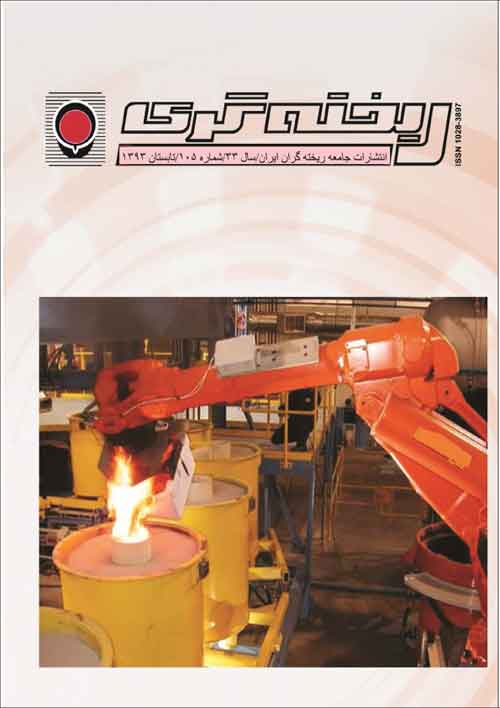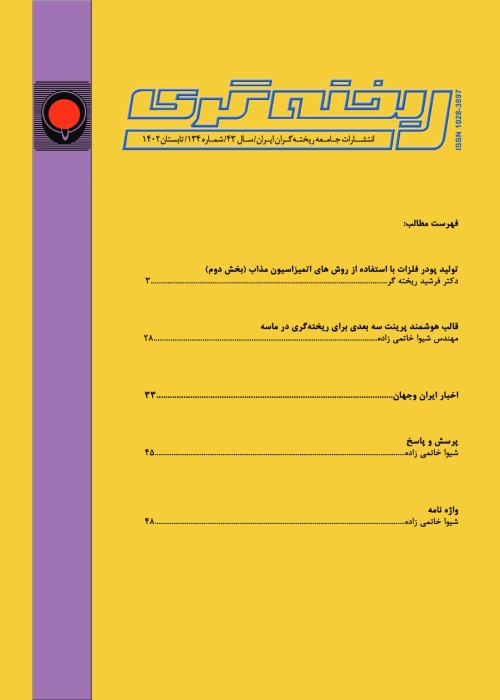فهرست مطالب

نشریه ریخته گری
پیاپی 105 (تابستان 1393)
- تاریخ انتشار: 1393/06/30
- تعداد عناوین: 8
-
-
ریخته گری آلومینیم روی بستری از گلوله های پلیمری با چیدمان منظم برای تهیه فوم آلومینیمی سلول بستهصفحه 2
-
بررسی رفتار سایشی زره های دیواره ی آسیای سنگ آهنصفحه 13
-
بررسی رشد دانه آستنیت و تاثیر رسوبات عناصر میکروآلیاژ در فولادهای خطوط لولهصفحه 26
-
تاثیر عملیات پایدار سازی عامل حباب زا در تولید فوم های آلومینیمیصفحه 35
-
بررسی ریزساختاری فوم های ریختگی چدن نشکن تولید شده با استفاده از گوی های توخالی آلومیناییصفحه 49
-
مقایسه ریزساختار و سختی کامپوزیت در جای Al-Mg2Si تهیه شده از روش های ثقلی، سطح شیبدار ساکن و سطح شیبدار لرزانصفحه 59
-
بررسی تاثیر اعمال ارتعاش بر اکسیدفیلمهای دولایه موجود در آلیاژهای A356 و A357صفحه 70
-
تاثیر فرایند کرنش اعمالی جهت فعال سازی مذاب بر روی ریز ساختار و خواص کششی آلیاژ Al-4. 0Cu-1. 2 Pb-1. 1Mg-0. 8Mn جوانه زایی شده با آمیژان Al-5%Ti-1%Bصفحه 83
-
Casting of the closed-cell A356 AL-foam by using stackedorder polymer granulesPage 2In this investigation has developed an innovation method for casting of Al-foams by using of polymer granules as the stacked-order precursors. The stacked-order precursors are placed in metallic mould cavity and then Al liquid is cast. The Al-liquid flows among of the polymer granules and fill the cavity and then the metallic mould quenched in water before burning of the polymers. In this case all characteristics of the closed-cell Al foam, such as diameter, wall thickness, numbers and distribution (order) of bubbles will be designable. In this investigation has presented casting technology of the ordered-closed-cell Al Foam which is a kind of high strength foam. Finally deformation of the ordered-closed-cell-Al foams is simulated and compared with experimental results. Results show a good consistency between the experimental and numerical data.Keywords: Ordered-closed cell Al foam, casting, quasi-static pressure, numerical simulation
-
Investigation of wear behavior of shell liner in iron ore grinding millPage 13In the present paper, the wear behavior of Chadormalu Industrial Complex grinding mill shell liners is investigated. Metallurgical and tribological studies were done on the well-worn liners of a semiautogenous grinding mill (SAG mill). The wear pattern of different area of liner, hardness, and microstructure changes caused by wear, were evaluated by means of visual inspection, optical and scanning electron microscopes and hardness measurements. Results indicated that wear volume was different along the liner length. The maximum wear loss happened in the lifter area where the grinding mill charges fell on. In addition the microstructure and hardness of the lifter of liner from the initial surface to interior depth have meaningful differences that can be intensified the wear rate. Simultaneously studies of worn surfaces and microstructure showed that the retained austenite in martensitic matrix reduced the wear resistance of liner because of transformation of retained austenite to martensite which lead to formation and propagation of cracks as well as acting the abrasive wear mechanisms such as microcutting. On the other hand, martensitic plates are origins of fatigue cracks. The results demonstrate that impact-abrasive and fatigue mechanisms are the dominate wear mechanisms.Keywords: Grinding Mill Liner, Wear Mechanism, Impact-Abrasive Wear, Fatigue Wear, Retained Austenite
-
Investigation of austenite grain growth and effects of microalloying elements precipitate in line pipe steelsPage 26A literature review shown that limiting austenite grain is reached due to holding in high temperatures. Austenite grain growth is influenced by pinning effect due to precipitations and potential dissolution of microalloying element carbonitride. Thermal cycles during welding or heat treatment can alter limiting austenite grain and change in transformation products and have crucial effects on final properties of steels. The main goal of this study is investigation of limiting austenite grain growth in two microalloyed steels and effect of microalloying element in limiting austenite grain growth.The main cause of grain growth at temperatures below 1150°C is dissolution of fine niobium carbonitrideand at temperatures above 1150°C is dissolution of coarse niobium carbonitride Titanium nitride dissolution is observed at temperatures above 1250°C. X65 steel has greater austenite grain growth than X70 due to lower titanium and TiN contents. Differences in limiting austenite grain size increase with increasing in temperature and reaches up to 38 micron in 1250°C.in 1350°C with gradual dissolution of TiN for both steels, differences in limiting austenite grain size decreases and reaches to 5 micron.Keywords: austenite, grain growth, microalloyed steel, precipitate, kinetic
-
Effect of stabilizing the blowing agent in the production of aluminium foamsPage 35Aluminium foams have achieved large interests over the past few yearsbecause of their light weight and high strength. There are several ways to produce aluminium foams but the most practical and the strongest ones are produced by powder metallurgyprocess. In thistechnique, TiH2 as the foaming agent is mixed with the other metal powders. Then the mixture is formed to tablet-shape samples via successive cold and hot compactions. The tablet-shape sample is a precursor of the final foam product which can be foamed at the appropriate temperature. Due to low temperature of TiH2 decomposition andhydrogen release (400°C) compared to the melting point ofaluminium alloys, TiH2 powderneeds to be stabilized before mixing it with the other metal powders. In the present study, the effects of time, temperature, and atmosphere (air and Ar) has been investigated on the stabilizing of TiH2 powder.Hydrogen mass spectrometry test was performed on all samples to achieve the optimum condition. Results indicate that TiH2 heat treatment in air shifts the gas release temperature to 520°C while only 38% of hydrogen content is reduced in the process. Considering the optimum condition of TiH2 heat treatment, Al, Si, Mg and TiH2 powders were mixed, hot pressed, heated for 20 minutes at the semi-solid temperatures of the alloys in a resistance furnace to produce the metallic foam. Macro and micro structures ofall samples were also investigated.Keywords: Aluminium foam, Stabilized TiH2, Al-Si-Mg alloy
-
Investigation of microstructure of ductile iron foam produced by hollow alumina spheresPage 49Cellular metals can be manufactured in various techniques, one of the known techniques as the use of space holder. After casting the molten metal around the space holders, they are removed and the cells are created. In this paper, alumina hollow spheres are used as space holder. Production of alumina hollow spheres is carried out by a powder base technique. In this technique, a suspension of alumina powders and sodium silicate as binder was coated on polystyrene cores. Pyrolysis of polystyrene cores was carried out at 100 °C temperature in 1h and alumina hollow spheres were manufactured. Manufactured hollow spheres were placed into the sand mould cavity and then, molten ductile iron was casted into mould. After cooling and solidifying, ductile iron foams were manufactured. Light microscopic evaluations were carried out on polished and etched specimens at various magnifications. Results show that microstructure of specimens involves of pearlite and ferrite surrounded nodular graphite. In specimens containing of the smaller alumina hollow spheres, the thickness of the cell walls decreases and cooling rate increases. Therefore, carbide phases were formed in microstructure.Keywords: Ductile iron, Hollow alumina spheres, Spherical graphite, Porosity percent
-
A Comparison between the Microstructure and Hardness of In-situ Al-Mg2Si Composites Produced via Gravity Casting, Still Cooling Slope and Vibrating Cooling SlopeMethodsPage 59In-situ Al- Mg2Si composites due to their low density and good mechanical properties have been attracted by automobile and aerospace industries. However, the coarse Mg2Si particles that form during the solidification of the alloy can lead to inferior mechanical properties of the composite.Therefore, in order to improve the strength and formability of the composite, these reinforcing particles should be modified. In this study, for the first time, the Vibrating Cooling Slope(VCS) methodhas been utilized to produce in-situ Al-25 wt.%Mg2Si compositeand the results are compared with those obtained via still cooling slope (CS) and gravity casting (GC) methods. Casting of Al-25 wt.%Mg2Si alloy with 100o C superheat was performed using a cooling slope (with the length of 40 cm, set at 45° inclined angle)while it was vibrating at the frequency of 40 Hz. The results showed that the VCS processed sample, in the as-cast condition (without need for any re-heating process) exhibited considerably finer Mg2Si particles with improved morphology distributed more uniformly within the matrix as compared to still cooling slope and gravity casting samples. In addition, although the porosity of samples produced via gravity casting, still cooling slope and VCS methods increased respectively, the cooling slope processed samples exhibited higher hardness than that of the gravity casting.Keywords: In-situ Al-Mg2Si composite, Vibrating cooling slope, Size of Mg2Si, Morphology of Mg2Si, Porosity, Hardness
-
Effect of vibration on the behavior of double oxide film defects in A356 and A357 in liquid Aluminum alloyPage 70The effect of vibration on the behavior of double oxide film defects in A356 and A357 liquid Aluminum alloy was investigated by a reduced pressure technique. The vibration was induced periodically with a constant frequency and constant domain. The results were compared to the results of an experiment in which the melt stayed stagnant. The results showed that the vibration caused the dissolution of hydrogen in the melt to increase. The cracking of double oxide film defects due to the vibration also caused the rate of consumption trapped atmosphere and the rate of the diffusion of hydrogen into the atmosphere of the defect to increase.
-
properties of an Al-4.0Cu-1.2Pb-1.1Mg-0.8Mn aluminum alloy modified by Al- 5Ti-1B grain refinerPage 83This study was undertaken to investigate the influence of Al5Ti-1B master alloy on the structural characteristics and tensile properties of Al-4.0Cu-1.2Pb-1.1Mg-0.8Mn aluminum alloy. The results showed that the optimum Ti amount to achieve a fine-grained structure was found to be 0.03 wt%. Then the un-refined and Ti modified-alloy was produced by modified strain-induced melt activation (SIMA) process and reheating conditions to obtain a fine globular microstructure was optimized. In order to investigate the effect of strain-induced melt activation (SIMA) process on the microstructures of un-refined and 0.03 % Ti-refined 2007Al alloy optical and scanning electron microscopy (SEM) were used. The specimens subjected to deformation ratio of 30% (at room temperature) and various heat treatment times (520 min) and temperature (600625 °C) regimes were characterized in this study. By increasing of the holding time at 615 ◦C, an increase in the shape factor and a decrease in the globule size of the samples were observed. Optimum combinations of average globule size and shape factor were obtained in a holding time of 10 min. Therefore 30 % applied strain and maintained at a temperature of 615°c for 10 min, reduce the grain size to 60 μm in un-refined and 45.3 μm in Ti-refined, in addition increased sphericity of grains to 85% in un-refined and 95.5% in Ti-refined. The tensile properties also increased by SIMA processing in both un-refined and Ti-refined samples.Keywords: Al-5Ti-1B, Al-4.0Cu-1.2Pb-1.1Mg-0.8Mn aluminum alloy, SIMA process, microstructure, tensile properties


